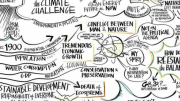Planting mangrove trees on the shores of Vietnam is helping protect against global warming – and also sowing the seeds of female empowerment.
Tran Thi Phuong Tien remembers when the floods came. Sitting at her cafe in Hue city, where she roasts her own coffee beans and serves sizzling beef that draws customers from the other side of the Perfume River, she recalls how Tropical Storm Eve hit the coast in October of 1999, pounding the region with more than its monthly average of rain in just a few days. The massive rainfall, which landed mostly upstream, conspired with the tide to cause the largest natural disaster for the area in the 20th century. The sea spilled aggressively through the narrow, unprepared streets of the communes and the single-storey homes of Hue. The unfeeling water rose shockingly fast.
The flooding continued for four days. Tran and her family fled to her mother’s house. At one point her husband took a boat back to their house, diving under the water to get inside and surviving on a stash of energy drinks left over from Tran’s old job for the few days he spent there. Government staff were tossing balls of cooked rice through the windows of homes across the river, but on her side the flooding was too extreme for even meagre rescue efforts like that. Most of their furniture was destroyed. After the waters receded, she saw dead bodies everywhere: dogs, cats, buffalo, humans. The mud left on the walls refused to yield to her cleaning efforts. She heard about a family – a grandmother, a grandfather and their two grandchildren – who knew they would die and tied themselves together so their bodies wouldn’t wash away.
An estimated 600 people died in those few days, and the damage amounted to about $300 million. It left the province of Thua Thien Hue, and others in that region of north-central Vietnam, fearful of the next time the sea would come to claim the land as its own.
Greedy waters have often held the province in their clutches. In November 2017, floods from Typhoon Damrey affected more than 160,000 households in the province, killing nine people, and causing about $36 million in damage. But it’s the 1999 flood that haunts. From beneath her wispy fringe, Tran looks at the dirty pond across the street from her café as if bracing herself for what it might become.
The 1999 disaster is what people in Thua Thien Hue talk about when you ask them about climate change, as reflexively as a hiccup, as if it were a textbook example. The connection isn’t accurate, explains Pham Thi Dieu My, director of the Centre for Social Research and Development, a Hue-based nonprofit. The cyclical, if severe, storm had the fiendish luck of bringing together heavy rains, high tide, and a lack of preparation. But for Pham, who has been educating the community about climate change, the memory has been crucial for waking up residents – women in particular – to the realities of their future.
Vietnam’s Ministry of Natural Resources and the Environment predicts that, if emissions remain high, the average temperature in Thua Thien Hue will rise by up to 3.7 degrees Celsius by the end of the 21st century. Annual rainfall will increase by 2–10 per cent. Sea levels will rise by up to 94 cm. Rising sea levels combined with increased rain will flood the low-lying plains in which the province sits. At the same time, the water on which some crops depend may become fatally salty when dry season droughts fail to bring enough rain to balance out the salinity of ocean water. The 1999 flood, says Pham, makes it easier to understand what’s coming.
As a strategy it works. The example of the flood, coupled with other recent changes – temperatures so hot that farmers had taken to planting rice at night, and low rainfall that left waters too brackish for rice and many fish to thrive – proved to the people of Thua Thien Hue that climate change wasn’t just coming, it was here.
So when Pham approached the local branches of the Vietnam Women’s Union, with a simple idea to help the land and sea withstand the coming danger, she found willing volunteers. They didn’t need marches or commitments from world superpowers to catalyse them into action. The women of Thua Thien Hue were ready to rescue themselves. And in doing so, they joined a global movement to preserve and restore one of the most crucial and widespread – yet neglected – tools for thwarting climate-driven destruction: mangrove trees.
Le Thi Xuan Lan is laughing at me. I deserve it. We are walking towards her small rectangle of water, a pen bordered by low, sandy dykes walling it off from the Tam Giang lagoon along the central coast of Vietnam. There, she harvests shrimp and crab to supplement the money she earns collecting trash in her commune three times a week. But reaching her pond requires crossing a bridge – if you can call it that. Pipes of grey bamboo bound together and bolstered by narrow, upright planks stretch across an inlet. A single horizontal pole made of bamboo offers a rickety railing that inspires scant confidence. The bridge spans just 30 feet or so, but I’m clumsy and fearful of dropping my notebook and recorder, so I clutch the railing with two hands and take the bridge sideways. Behind me, Le, who is 61, howls with laughter and jumps on the bridge without holding on. Behind both of us, the South China Sea lies flat and calm, as if it plans to stay that way.
Earlier that day, our feet sank into the hot, black, squishy shore by a 16-month-old patch of mangrove trees that she had helped plant. The young trees looked like boy soldiers, thin and lanky, their heads of green, leathery leaves hovering just a foot or so above the water. Le, clad in a pink hoodie and black pants – covered head to toe despite the boiling air, as is the way in South-east Asia – bent down to clear seaweed from the still-tender roots. She tossed away a rock that had come to rest nearby, like a mother wiping food from a toddler’s face. Keeping the small trees free of anything that could stifle their growth is vital to their success. And their success, she knows, is vital to her survival. In a few years, the mangroves will be there to keep floodwaters from swallowing her village whole. Or so she hopes.
Mangroves are a testament to the miracle of trees. Of the 60,000 or so species of trees on Earth, only mangroves tolerate saltwater. They thrive where freshwater mingles with the ocean, just beyond the shores of more than 90 countries in South-east Asia, South America, North America, Africa, the Middle East, the Caribbean and the Pacific. Their thick tangles of ropey roots capture river sediment, thereby reducing beach erosion and preventing pollutants from flowing into the ocean. A 100-metre-wide swath of mangroves can reduce the height of a wave by as much as two-thirds. They sequester carbon three to five times more powerfully than upland tropical forest.
Mangroves are often referred to as “the nurseries of the sea” – clusters of them make breeding grounds for fish and crustaceans. Although exact estimates are hard to come by, it’s likely that hundreds to thousands of fish species spend their lifecycle around mangroves. Researchers estimate that 80 per cent of the global fish population is dependent on healthy mangrove ecosystems, and in turn 120 million people worldwide depend on them for income. Migratory birds also make seasonal homes in mangroves.
All of this makes planting these trees an ideal project for a type of climate change preparation known as ecosystem-based adaptation – the harnessing of natural resources to build resilience to climate change. It may be best understood by what it isn’t: grey. Sea walls, reservoirs and dykes built of hard materials are the opposite of ecosystem-based adaptation (EbA). Such structures are typically the result of top-down decisions and funding. EbA, by contrast, is bottom-up and focused on the connection between people and their environment. It is most effective, says Philip Bubeck, who researches climate change adaptation at the University of Potsdam in Germany, if the humans directly intertwined with a given ecosystem are the ones involved in saving it. Planting mangroves is one example of EbA. Others include reforestation to eliminate food insecurity in Mexico, the establishment of no-fishing areas, and the clearing of litter in urban areas in South Africa.
Nature-based solutions for adapting to climate change aren’t always paid much heed. Although EbA as a formalised concept is more than ten years old, a recent report from the United Nations noted that just 1 per cent of the global investment in water infrastructure goes toward this approach. Bubeck says that because the projects involved are usually small and local, national governments have little control, which can cause tension in countries where government officials are used to calling the shots. The good results can take years to reveal themselves, and that’s often too long for politics.
All this is slowly changing. Nature-based projects are gaining more attention – and more funding. The poor, vulnerable people who are most susceptible to the damage that climate change will bring are finally being included, consulted, and heard. In Thua Thien Hue, that means women.
Women’s inequality makes them particularly vulnerable to the hazards of climate change. In Vietnam, says Pham, “women have important roles but are not fully recognised by society”. Their resilience is hampered by social, cultural and political disadvantages. Because they are the primary caregivers to children, the elderly and the sick, women are not as free to seek shelter from the storm when doing so means moving to another location. They often earn money in the so-called “informal sector” – selling noodle soup or roasted pig on the sidewalks of Hue, for example, or caring for a young family at home – leaving them financially insecure, especially when calamity strikes. And they tend to hold far fewer roles in the government, which means their particular needs, such as hygiene requirements, often aren’t part of disaster management discussions.
Pham wanted to change that. Growing up in rural Quang Binh province, she liked the floods that arrived every year during her childhood. “I played in the water, it was fun,” she says, “and we had no school during the floods.” But 1999 changed that. “I saw so many people dying,” says Pham, now 40. At her office at the Centre for Social Research and Development (CSRD), a merciful air conditioner hums faintly in the background. A few men and women work in near silence while Pham’s four-year-old daughter tries to keep herself busy. A sizeable fish tank containing just a single plant sits on a shelf above the blonde wood table where we’re sitting.
Climate change was still emerging as a national issue when Pham started working here in 2008. The following year, the team here joined researchers from the Institute for Environmental Studies and Vrije Universiteit Amsterdam, both in the Netherlands, on a wide-ranging project known as ADAPTS, funded by the Dutch Foreign Ministry. In Vietnam, this focused on planting mangroves and also fruit trees for the shade and extra income they provide.
The project achieved its aims of planting trees and galvanising locals to protect their homes. It also attracted the attention of the government, which then asked CSRD to draft a province-based action plan for climate change adaptation. But Pham knew whatever they did next had to address gender inequality, an issue that was baked into CSRD’s mission and also was proving essential for climate change adaptation.
Women were crucial to protecting their communities against the intensifying natural hazards and healing them afterwards, Pham and the founding director of CSRD, Thi Thu Suu Lam, wrote in 2016. “However, women are underrepresented in decision-making at all levels.” And with little time to spare for learning, women couldn’t do much to prepare for disasters beyond stacking their furniture.
One morning in a small, coastal village called Ngu My Thanh, populated by about 220 households, I watch as neighbours build a fish trap together. Mothers and daughters tie white netting onto long, thin dowels that stretch from the porch into the house. “We worry about it,” says Vui, one of the mothers, when I ask her about climate change. Her tone is casual and her adaptation plan is limited. “We can arrange the furniture in the house,” she says, “and stock food.” The daughters, around ages 8 to 12, know little if anything about rising global temperatures or the threat that poses to Vietnam. “They haven’t learned anything yet,” another woman says, as if she’s been asked to prove Pham’s point. “They’re busy earning their lives, they don’t have time.”
Pham had global support for her conviction that any future project on climate resilience had to address gender inequality. The Sendai Framework for Disaster Risk Reduction, a 15-year, non-binding agreement put forth by the United Nations in 2015, called for more attention on the role of women in disaster risk management. Women, it stated, “are critical to effectively managing disaster risk”. And yet Pham also knew that in Vietnam, being critical didn’t mean being treated that way. In 2016, for example, the Flood and Storm Control Committee of Thua Thien Hue included one female member but the province planned projects and policies “without meaningful consideration of [women’s] capacities, needs and interests,” Pham and Thi wrote. Members of the province’s Women’s Union told Pham and Thi that their involvement was passive at best.
As Pham prepared for the next project, she knew this inequality had to be addressed first and foremost. And she believed that doing so would make all the difference when it came to safeguarding the future of Thua Thien Hue.
In 2017, Pham and the Dutch team received $500,000 for a new mangrove project, the one for which Le Thi Xuan Lan planted trees. Called ResilNam, it is funded by the Global Resilience Partnership Water Window, a collection of public and private organisations that awards money from Z Zurich Foundation, a private Swiss grant foundation supported by the Zurich Insurance Group.
Drawing on the knowledge of locals, the team identified two spots for planting mangroves. One site, Hai Duong, where Le had laughed at me, had never seen mangroves before. The other was two hours south in a rural district called Loc Vinh, where locals had once been forced to flee as American soldiers moved in to destroy a Viet Cong base. There, mangroves already flourished in the warm, jade-green waters where the Bu Lu River flows into Lang Co bay, where desolate beaches lure pale vacationers. The ResilNam project offered a chance to expand their reach.
Starting in March of 2018, just after flood season, locals at each site planted hundreds of trees, mostly purchased from nurseries in nearby provinces. In Loc Vinh, about 20 men and 10 women planted enough trees to cover two hectares of coastline. For each day’s work they earned 250,000 dong (about $11, or enough to buy ten loaves of bread in Hue), paid from ResilNam grant money.
Beginning in the late afternoon, after the tide receded for the day, the men dug holes 20 to 30 cm deep, two metres apart, and the women planted the trees. Healthy mangroves nearby fed their inspiration. Regard for the landscape they’d been forced out of during the war fed their motivation.
“Growing mangroves makes things more beautiful,” says Le Cuong, 55, who helped plant the mangroves and built a fence to protect the saplings. The late afternoon planting sessions filled the workers with a sense of purpose, “because we were helping to do something to protect the environment”. The ResilNam team estimates that 12,000 people will directly benefit from the new mangroves, with an additional 180,000 people reaping some tangential reward.
But ResilNam wasn’t just about planting trees; it was also about planting seeds. Pham and the research team held workshops and other events within several communes to educate women and engender confidence to voice their needs. They organised focus groups for women to discuss how severe weather shaped their lives and what they could do about it. They also established a micro-credit programme that lets households in the village encompassing one of the mangrove sites borrow funds; caring for the mangroves during that year is part of the loan agreement.
At the local branches of the Women’s Union, members learned about climate change and held karaoke sessions with a song list themed entirely on the topic of flooding. Women were trained to host tours of the mangroves, which will generate income for them. The capacity-building efforts of ResilNam reached 300 women directly and, the team estimated, another 1,500 by proxy.
The project worked. At the first community meetings with the ResilNam team, only men talked. Women, many of whom couldn’t read or write, didn’t speak. “They were marginalised,” says Pham. Gradually the women spoke up. And the ones who went first encouraged others to do the same. For Pham, the change she has seen among women in Thua Thien Hue has been just as significant as the new mangroves, if not more so. “That is the biggest achievement,” she says. Communes that held men-only activities have now opened those events to women. And, says Pham, women have a stronger voice in the plans and policies set by the Flood and Storm Control Committee.
§
Le Cuong, who is 55, takes me, along with my translator, out in his canoe-like boat to see the mangroves he and his neighbours have planted by Lang Co bay. He stands as he rows past enormous fishing nets and ramshackle huts where fishermen can nap in the shade while their traps catch their targets. He has to keep his mouth open to hold his conical hat in place because the string holding it under his chin is too loose. He is tanned and muscular and although he is clean-shaven, he has let a few white facial hairs sprouting from a mole grow several inches long. He tattooed the words “sad for my life” on his arm when he was 20 and upset with himself for not managing to travel overseas. Now, gliding through the bay, he is happy – happy to have done something to help the next generation, happy to have people to help, happy to expand the mangrove forest.
But it isn’t all happy in the bay. Le is sad for the life of the year-old mangroves. They have failed to grow. Where trunks should be thickening, spindly sticks poke the air, a handful of leaves sprouting from their tops. They look like a long row of pencils with decorative erasers, the tropical equivalent of Charlie Brown’s sparse little Christmas tree. Nearby, lush, older mangroves drop their green-bean-like fruits towards the water and extend their green-bean-like roots up towards the sky. Oysters cover the bark where the trunks meet the water and ducks wander in their shade. These old-timers are doing everything mangroves are supposed to do, but they can’t show the young, new shoots the way. The ResilNam team aren’t sure why the trees haven’t thrived here. Le suspects they planted the saplings at the wrong time of year and too deep in the water.
It is a somewhat cautionary tale. “There are so many failures all over the world,” says Ali Raza Rizvi, who manages the ecosystem-based adaptation programme at the International Union for Conservation of Nature and works with the Global Mangrove Alliance, a hub for sharing data and developing projects centred on saving mangroves. “It’s not easy.” The uncertainty faced by new saplings is one of several reasons that the priority needs to be on protecting current mangrove forests, says Rizvi. About 25 per cent of the global mangrove population has been lost since 1980, with between 12 and 20 million hectares remaining worldwide. Asia lost up to a third of its mangroves between the 1980s and 1990s. In South-east Asia, the trees have been uprooted mainly by aquaculture, but also by palm oil refineries, construction and rice agriculture. The degradation has slowed, but a 2015 study reported that it is currently continuing at 0.18 per cent per year.
Even if the trees are replaced, restoring the ecosystem that had developed around them could take years. The trees themselves need seven to ten years to become substantial enough to slow storm surges, shrink waves, and sequester enough carbon in their roots to make a difference. By contrast, the amount of carbon dioxide released each year from the roots of destroyed mangroves worldwide may equal the annual emissions of Myanmar. “Let’s protect and conserve the mangroves that we have,” says Rizvi, “and then restore.”
Hoang Cong Tin, an environmental scientist at Hue Sciences University, says that we should not view mangroves as independent ecosystems. Rather, they are part of a bigger ecology that also includes sea grass and salt marshes. Particularly when it comes to gauging the ability of these species to sequester carbon, the coastal ecosystem must be viewed – and preserved – as a whole, says Hoang.
Still, mangroves at the planting sites where the trees were new to the location are thriving. They show all the promise of becoming the ecological marvels that their ancestors have proven to be.
On a hot weeknight in July, Trinh Thi Dan, 58, emerges from her evening swim in the Perfume River. She’s one of many “aunties” who bathe in the river twice a day, using large plastic bottles roped around their bodies as flotation devices (many of them can’t swim) and dressed in clothing rather than bathing suits. She often carries trash out of the river when she leaves. A couple of days earlier, she pulled out a dead dog. “The river is like a mom hugging you,” she says. She wants to protect it. Another auntie, Tran Thi Tuyet, 57, soon joins her on the grassy bank. “Our group is addicted to the river,” she says. Tran sometimes makes it all the way home having forgotten to remove the garbage she’s stashed in her clothing while swimming.
Tran directs the Women’s Union in her town and has planted mangroves as part of ResilNam. The project, she says, transformed the women of her commune. “It’s totally different to how it was before the project,” says Tran. The women are more confident. They have more skills and knowledge. They are better equipped to take action before, during and after a flood. They are equal with men. “The men have to admit the contribution of women and accompany them side by side,” says Tran. She says she feels happy to be among those who’ve helped their environment.
As she speaks, the stillness of dusk descends over the river. Mountains, sky and water melt together into a trio of indigo. Birds circle above. Tran goes to join the few women still bobbing in the dark, placid water. She plans to swim to the other side.
This article first appeared on Mosaic and is republished here under a Creative Commons licence.





